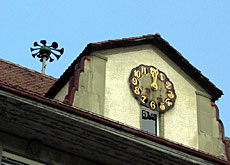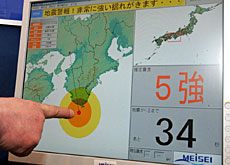How a small country copes with huge disasters

Switzerland is used to natural disasters, which makes it well qualified to react in the case of an extreme event. Risk prevention is the current priority.
With the International Day for Natural Disaster Reduction on Wednesday, swissinfo looks at how well prepared Switzerland is for the worst.
According to observers, Switzerland is by and large ready for major natural disasters.
“Switzerland reacted quite quickly to the floods in August. There is real progress compared to the flooding of 1999,” a spokesman for the reinsurance giant Swiss Re said. “Switzerland is well prepared but we can always do better.”
Switzerland is internationally recognised as being ahead of the game in the area of prevention, on which it spends SFr2.5 billion ($1.95 billion) a year. This was noted at the last conference on the subject in Kobe in Japan at the beginning of the year.
However, the Platform for National Hazards (PLANAT) has confirmed that there are some gaps and it has established a three-year plan of action adopted by the government last May.
“It is necessary for example that the maps of danger zones should be completed by all the cantons,” Florian Widmer, secretary of PLANAT, explains. “That’s one of the priorities for 2010-2011.”
This mapping of natural hazards has been in the pipeline for a long time and is progressing very unevenly from one canton to another. The pressure of certain interests, such as business and tourism, may be slowing down the process.
“We must urgently finish these maps so it is possible to take nationwide planning decisions, which are the cornerstone of prevention,” stresses Martin Kamber, of the Intercantonal Reinsurance Association.
Greatest risks
As for the main major natural disasters facing Switzerland, in terms of impact, an earthquake would clearly be the most destructive. Magnitudes of 5 to 6 on the Richter scale have been projected in Valais and Basel.
A quake such as the one that hit Basel in 1356 would cause SFr60 billion worth of damage compared with the SFr2 billion for the August floods.
Next in the line-up of major risks come floods, cold snaps, droughts and heat waves. These are followed by severe storms and avalanches.
“The paradox is that the rarest events entail the most risk,” Florian Widmer points out.
It has proven difficult to get people to take prevention seriously. One reason for this is that natural disasters supposedly remain in popular memory for just seven years – and a mere four years in political memory.
Federalism
Some people says federalism is an obstacle for the prevention of disasters and crisis management, but Kamber sees it more as an advantage that communes and cantons are responsible.
They know the lie of the land, he argues, and deliver better efficiency. And the little competition between cantons can, according to Kamber, act as an incentive for action.
Widmer is less positive. Although federal authorities can issue recommendations and directives in areas of prevention, he points out that the cantons are not obliged to apply them.
One example is the ongoing delay in the completion of the disaster threat map. A project to amend the constitution to strengthen federal authority on this issue recently ended up being shelved.
The drill
What happens in the event of a natural disaster all depends on the event. But in principle the commune or the canton concerned takes charge.
Firemen, police, sanitary services and civil protection would all pitch in. A management body made of the main players would be mobilised.
If the need on the ground is felt, these coordinating bodies could also be mobilised at a national level. In the case of large-scale events, the army would also get involved, as happened during the August floods.
Reaction plans are in place for the range of potential natural disasters, says Pascal Aebischer of the Civil Protection Office.
According to Widmer, however, the question of who is responsible for sounding the alarm has not been sorted out and levels of competence are yet to be clarified.
swissinfo, Pierre-François Besson
In the case of extreme weather or serious earthquakes, the National Alarm Centre sends the alerts of the Swiss Meteorological Office or the Swiss Seismological Service to the affected cantons, the army, the Federal Police Office and other parties.
The alert to the population is communicated by the 7,750 sirens spread across the country and normally operated by the cantonal police.
The population is then supposed to tune in to the radio stations of the Swiss Broadcasting Corporation for information.
Due to Switzerland’s federal system, federal authorities are only supposed to act in a support capacity in the case of a natural disaster.
The Civil Protection Office oversees everything to do with intervention on the ground.
The Federal Office for Water and Geology is responsible for prevention. It houses the secretariat of the extra-parliamentary committee PLANAT.
To fulfil its prevention brief, PLANAT brings together public authorities, researchers, insurers and other experts.

In compliance with the JTI standards
More: SWI swissinfo.ch certified by the Journalism Trust Initiative

You can find an overview of ongoing debates with our journalists here. Please join us!
If you want to start a conversation about a topic raised in this article or want to report factual errors, email us at english@swissinfo.ch.